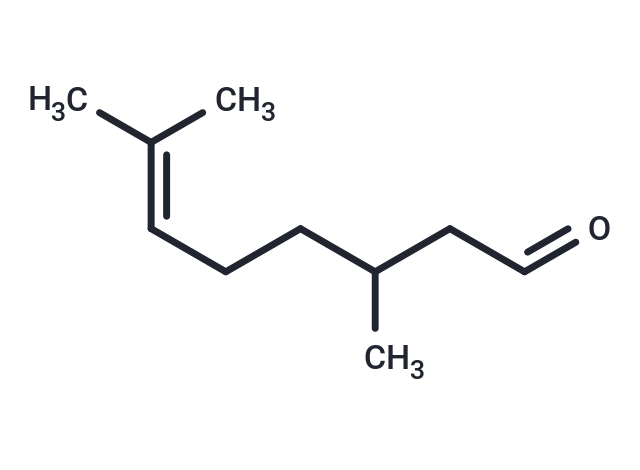Shopping Cart
- Remove All
 Your shopping cart is currently empty
Your shopping cart is currently empty

Citronellal ((±)-Citronellal) is a monoterpene predominantly formed by the secondary metabolism of plants, producing antithrombotic, antiplatelet, and antihypertensive activities.

| Pack Size | Price | Availability | Quantity |
|---|---|---|---|
| 1 g | $30 | In Stock | |
| 5 g | $64 | In Stock | |
| 10 g | $94 | In Stock | |
| 1 mL x 10 mM (in DMSO) | $30 | In Stock |
| Description | Citronellal ((±)-Citronellal) is a monoterpene predominantly formed by the secondary metabolism of plants, producing antithrombotic, antiplatelet, and antihypertensive activities. |
| In vitro | Administrations of Citronellal(CT) (50, 100, and 150?mg/kg) as well as lovastatin dramatically reduced the size of carotid atherosclerotic plaque in rats in a dose-dependent manner, compared with atherosclerotic rats fed with a high-fat diet plus balloon injury and vitamin D3. Mechanically, CT improved endothelial dysfunction, increased cell migration, and suppressed oxidative stress and inflammation in vascular endothelium in rats feeding on the high-fat diet plus balloon injury. Further, CT downregulated the protein levels of sodium-hydrogen exchanger 1 in rats with atherosclerosis[1]. |
| Cell Research | An AS model in carotid artery was induced by balloon injury and vitamin D3 injection in rats fed with a high-fat diet. The size of the carotid atherosclerotic plaque was determined by ultrasound, oil red, and hematoxylin-eosin staining. Endothelial function was assessed by measuring acetylcholine-induced vessel relaxation in an organ chamber[1]. |
| Alias | (±)-Citronellal |
| Molecular Weight | 154.25 |
| Formula | C10H18O |
| Cas No. | 106-23-0 |
| Smiles | CC(CCC=C(C)C)CC=O |
| Relative Density. | 0.857g/mLat 25°C(lit.) |
| Storage | Powder: -20°C for 3 years | In solvent: -80°C for 1 year | Shipping with blue ice. | |||||||||||||||||||||||||||||||||||
| Solubility Information | DMSO: 30 mg/mL (194.49 mM), Sonication is recommended. | |||||||||||||||||||||||||||||||||||
Solution Preparation Table | ||||||||||||||||||||||||||||||||||||
DMSO
| ||||||||||||||||||||||||||||||||||||

Copyright © 2015-2025 TargetMol Chemicals Inc. All Rights Reserved.